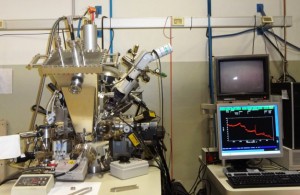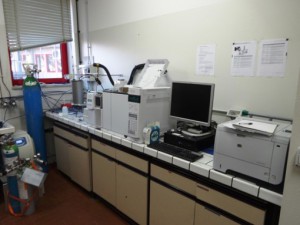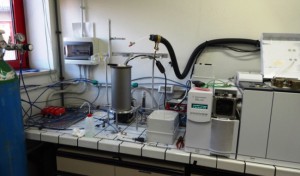IMPACT – Innovative Materials and Processes for Advanced Environmental Clean Technologies

Responsabile: Prof.ssa Antonella Glisenti, PA, Dipartimento di Scienze Chimiche
Composizione del GRE:
- Antonella Glisenti, PA
Aree di ricerca di afferenza:
Attività:
Research activity focuses on the investigation of the surface reactivity of nano-oxides and oxide based nanocomposites. The main objective of this research is to develop active materials to be used in heterogeneous catalysis. Particular attention is devoted to the green processes with the aim of developing oxide based materials for a sustainable development. Example of the applications:
- New Advanced Electrodes for Intermediate Temperature Solid Oxide Fuel Cells (SOFCs);
- PGMs free catalysts for advanced applications (Three Way Catalysts, sensors, as an example);
- Development of sustainable catalysts for clean hydrogen production (alcohols steam reforming and oxidative steam reforming, dry reforming).
The research activity mainly concerns the design, synthesis and characterization of oxide based nano-materials and nano-composites (perovskites, transition metal oxides, …). Nano-materials, synthesized with different procedures, are characterized with a multi-technique approach and their reactivity is investigated. By means of the interaction with probe molecules, the active (acidic/basic and red/ox) sites are investigated and the influence of their distribution and strength is considered with respect to the activity and selectivity in oxidation and reduction reactions (oxidation of alcohols, carbon monoxide and hydrocarbons, reduction of nitrogen oxides, …). Objectives:1) investigate the reaction mechanisms; 2) correlate the observed reactivity with the strength and surface distribution of active sites; 3) evaluate the influence of doping, synthesis parameters, etc. on the activity and selectivity.
Both the catalysts and the preparation procedures are selected taking into consideration the economic and environmental sustainability.
The reaction process is also investigated and optimized also with ad hoc developed reactors; the main interest is toward sustainable processes:
- CCS (Carbon Capture and Storage)
- CO2 conversion
- Emissions and Pollution control
- Biofuels
- Sustainable hydrogen production
Elenco delle ultime cinque pubblicazioni:
- Steam reforming and oxidative steam reforming of methanol and ethanol: The behaviour of LaCo0.7Cu0.3O3, Glisenti, A. Galenda, MM. Natile, Applied Catalysis A 453, (2013) 102-112 ISSN: 0926-860X
- Chemical Tuning versus Microstructure Features in Solid-State Gas Sensors: LaFe1-xGaxO3, a Case Study, M.M. Natile, A. Ponzoni, I. Concina, A. Glisenti, Chemistry of Materials 26, (2014) 1505-1513
- Electronic structure of SrTi1-xMxO3-d (M = Co, Ni, Cu) perovskite-type doped titanate crystals by DFT and DFT plus U calculations, Carlotto, M.M. Natile, A. Glisenti, A. Vittadini, Chemical Physics Letters 588, (2013) 102-108 ISSN: 0009-2614 ISSN: 1873-4448
- Co- and Cu-Doped Titanates: Toward a New Generation of Catalytic Converters, Glisenti, M.M. Natile, S. Carlotto, A. Vittadini, Catalysis Letters 144 (2014) 1466-1471
- “La0.8Sr0.2Ga0.8Fe0.2O3-δ: influence of the preparation procedure on reactivity toward methanol and ethanol”, Galenda, M.M. Natile, L. Nodari, A. Glisenti, Applied Catalysis B: Environmental, 97(3-4) (2010) 307-322 ISSN: 0926-3373.
Contatti:
Department of Chemical Sciences – University of Padova
Via F. Marzolo, 1
Tel +39 049 8275176
www.chimica.unipd.it/antonella.glisenti
Laboratory for the synthesis of oxide based advanced functional materials
In this laboratory the nanoscale oxide based materials (nanosized oxides and nanocomposites) are conceived, designed and synthesized, by cost effective and environmentally sustainable wet chemistry processes.
Laboratories for the nanomaterials and nanocomposites characterization
In these laboratories the following characterizations are carried out:  Physico-chemical characterization
Physico-chemical characterization
- UV-Vis Spectroscopies
- FT-IR Spectroscopies
- BET (Powder Specific Surface Area)
- TPR (Temperature Programmed Reduction)
- TPD (Temperature Programmed Desorption)
- XRD (X-Ray Diffraction)
- High Pressure TGA (Thermo Gravimetric Analysis)
Surface specific characterization
- XPS (X-Ray Photoelectron Spectroscopy)
- SEM (Scanning Electron Microscopy)
- XRF (X-Ray Fluorescence)
- DRIFT (Diffuse Reflectance Infrared Fourier Transform) Spectroscopy
Surface Active Sites Characterization DRIFT Spectroscopy in Operando
- Study of surface functional groups and contaminants (hydroxilation, carbonatation …)
- Characterization of the active sites (acidic/basic, redox) by chemisorption of probe molecules
- Reaction mechanisms investigation.
Laboratory for functional characterization


- Reactors with fixed beds: catalytic activity measurements; powders, pellets and/or structured catalysts (honeycombs) can be tested.
- Oxygen permeability chamber: investigation of oxygen mobility and mixed ionic/electronic conduction.
- Extensive and versatile set of gas metering lines: used to prepare complex mixture of gases to be fed to the testing reactors and instruments.
- Online gas characterization instruments (GC-MS, FT-IR): required to measure the gas composition during activity tests; all of them can operate automatically, to carry out dynamic and long-lasting experiments.
- Gruppi di ricerca: IMPACT - Innovative Materials and Processes for Advanced Environmental Clean Technologies






